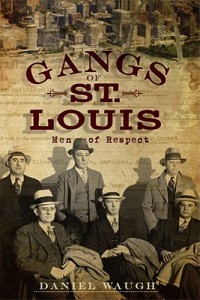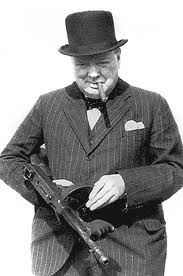Last week I picked up a copy of Daniel Waugh’s new book called Gangs of St. Louis: Men of Respect. I finished it in less than a week….a busy week at that. I found myself reaching for it any time I had a free moment. There are so many familiar names and places mentioned over and over that you can almost visualize the events. The book follows the history of street gangs during the Prohibition Era; roughly 1919-1932. The gangs have colorful names such as “Egan’s Rats” and “The Cuckoo Gang” and they engage in a variety of criminal activity. Prohibition provided their main avenue for revenue by way of bootlegging liquor and beer and then distributing it throughout St. Louis City, St. Louis County, and Madison County, Illinois. Bullets are flying on every page of the book and often an individual is introduced to us in one paragraph and is killed off in the next. This is due to the gangs bickering and engaging in full on warfare initially over bootlegging and extortion rackets and later in the book moving up to labor racketeering and narcotics distribution. This can be hard to keep track of but Waugh gives a list of gangs and their members for us to reference while reading.
it any time I had a free moment. There are so many familiar names and places mentioned over and over that you can almost visualize the events. The book follows the history of street gangs during the Prohibition Era; roughly 1919-1932. The gangs have colorful names such as “Egan’s Rats” and “The Cuckoo Gang” and they engage in a variety of criminal activity. Prohibition provided their main avenue for revenue by way of bootlegging liquor and beer and then distributing it throughout St. Louis City, St. Louis County, and Madison County, Illinois. Bullets are flying on every page of the book and often an individual is introduced to us in one paragraph and is killed off in the next. This is due to the gangs bickering and engaging in full on warfare initially over bootlegging and extortion rackets and later in the book moving up to labor racketeering and narcotics distribution. This can be hard to keep track of but Waugh gives a list of gangs and their members for us to reference while reading.
To put it in perspective, at the time of prohibition St. Louis was the 4th largest city in the United States . It was a manufacturing and distribution hub home to some of the largest companies in the world, numerous factories, warehouses, and stockyards. The population of the city proper was almost 3 times the current population at close to 900,000 people. The streets were teeming with people and it was dirty, polluted, and crowded. The gangsters that were running these rackets operated independently but worked closely with the Chicago Outfit (Capone), Kansas City and Detroit mobs, and even New York on occasion.
The mafia in St. Louis was never the strongest gang because of different factions within it constantly struggling for power and warring with one another. The title of the strongest gang probably belongs to the southside Cuckoo Gang who later morphed into the Syrian/Lebanese mob lead by “Horseshoe” Jimmy Michaels. Michaels is one of the most interesting characters in St. Louis history much less this book or organized crime. He could be the subject of his own book and it would be a great read. The details in this book give great insight into his early associations and exploits
One of the most striking things about the time period is that the line between mob boss and politician seems to be blurred in way that was very transparent to the average citizen. For example, the leader of one of the most powerful gangs in the early 1920’s was Edward “Jellyroll” Hogan. Hogan also happened to be an elected member of the Missouri State Senate. He was linked to numerous crimes and his brother was even implicated in several murders while he was in office. Jimmy Michaels also went on to be a respected member of the St. Louis community. He routinely associated with local politicians and even had a voice in Jefferson City on some matters.
This book had me laughing out loud on several occasions as well. Jellyroll Hogan provided one of those occasions for me when he was being questioned about recent murders by police in his office. Their intent was to arrest him in connection with the crimes but they came up empty during the questioning. Jelly Hogan sees the men out of his office, dutifully shakes their hands and reminds the officers to vote for him in the coming election.
Another recurring theme in the book is that these gangsters will not talk to police at any point if they have been the victim of a shooting or any other crime. The humor comes from the fact that by the end of the 1920’s the Thompson Sub Machine Gun “Tommy Gun” was the weapon of choice for most gangsters. So basically, a gangster who had been shot would show up to the hospital after being sprayed with bullets from a machine gun. The hospital workers would promptly call the police in to investigate. If the gangster had survived to this point he would simply explain that his numerous bullet wounds were the result of a “hunting accident”….Perfect.
 The invention of the Tommy Gun seems to have given the criminals more firepower than law enforcement. Its a gun that is capable of firing hundreds of rounds within seconds and is extremely hard to control. It was also prohibitively expensive costing about $200 at a time when a new Ford cost $400 (according to wikipedia). It was such a powerful weapon that it was in use by the US military until 1978.
The invention of the Tommy Gun seems to have given the criminals more firepower than law enforcement. Its a gun that is capable of firing hundreds of rounds within seconds and is extremely hard to control. It was also prohibitively expensive costing about $200 at a time when a new Ford cost $400 (according to wikipedia). It was such a powerful weapon that it was in use by the US military until 1978.
Another reason that the book is interesting is that the backdrop for these events are the streets and neighborhoods that I drive day to day. The Cuckoo Gang originates as a baseball team in the Soulard Neighborhood. Several important events in the book take place on the streets of Lafayette Square and Lasalle Park Neighborhoods. The mafia operates on The Hill and Little Italy. Little Italy seems to be an area that would comprise the Southern portion Old North St. Louis and a mostly abandoned portion of the city between the heart of Old North and Downtown. Kerry Patch, an Irish section of town, also falls in the Old North St. Louis neighborhood partially as well as the Near North Riverfront. Numerous other familiar locations in South County, Lemay, and the Metro East are referenced throughout the book.
The book winds down with Anheuser Busch holding a ceremony at its headquarters on Pestalozzi to celebrate the repealing of the Volstead Act and alcohol becoming legal again. The author then gives a brief account of the fate of each gang and every individual who was lucky enough to live through the violent wars that are detailed in the book.
Ultimately, this book is about immigrants and 1st generation Americans who were mostly uneducated and didn’t have many opportunities. This coupled with poverty causes many young people to turn to a life of crime even today. Those who made it through and survived were able to give their children and grandchildren more opportunities than were afforded to them. As unsavory as it may be this was part of the American dream that brought so many immigrants here around the turn of the century. Not to say that immigrants came here to engage in organized crime, this was just part of the process that some had to partake in to survive and move up in the world.
I would recommend this book to anyone who has even a mild interest in St. Louis history. There are countless books that deal with Lewis and Clark, The Louisiana Purchase, Dred Scott, and the 1904 World’s Fair. This is a period of St. Louis history that is woefully under-represented and at the same time is a period that many of us can probably relate to most closely. All of my German and Sicilian ancestors arrived in St. Louis around this time and lived in these neighborhoods with these people.
I can see where historians might have a problem with some aspects of the book because the author takes some creative liberties on more than a few occasions, but overall the book is very well researched and very, very entertaining. Waugh has an entire book dedicated to Egan’s Rats, a gang that is featured in this book as well. I plan to pick that one up in the near future.
For more information on the Tommy Gun check out its wiki page
http://en.wikipedia.org/wiki/Thompson_submachine_gun
Pick up a copy of the Gangs of St. Louis from a local book store. Left Bank Books in the Central West End and Downtown both stock it.
